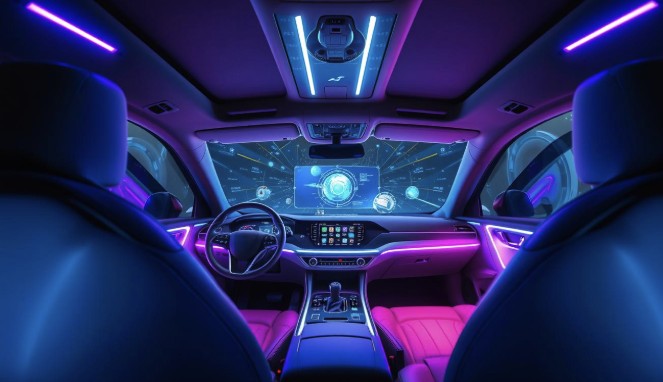The automotive world is witnessing a revolution in car interior design, with 2025 bringing unprecedented innovations that blend comfort, technology, and sustainability. Whether you drive a luxury sedan, a family SUV, or a classic model in need of modernization, the right interior upgrades can transform your daily commute into an extraordinary journey. This guide explores cutting-edge car interior upgrades for 2025 that are redefining what's possible inside your vehicle.
Why 2025 Is the Year of Smart Car Interiors
The automotive industry has shifted focus dramatically toward interior experiences, recognizing that drivers spend more time inside their vehicles than admiring them from the outside. This year marks a turning point where technology, comfort, and personalization converge to create truly intelligent cabins.
Next-generation car interiors combine advanced technology with premium comfort
Enhanced Comfort
Modern upgrades focus on ergonomics, temperature regulation, and personalized seating that adapts to individual body types. The latest materials offer breathability and support for even the longest journeys.
Integrated Technology
From AI-powered climate systems to augmented reality displays, technology integration has reached new heights, making vehicles extensions of our digital lives.
Sustainable Design
Eco-conscious materials and energy-efficient systems are no longer optional extras but central features of premium interior upgrades in 2025.
Emerging Technologies Reshaping Car Interiors
The technological revolution inside vehicles has accelerated dramatically, with innovations that were once science fiction becoming standard options for interior upgrades.
AI-Driven Climate Control Systems
Artificial intelligence has revolutionized how we experience comfort in our vehicles. The latest climate control systems learn your preferences over time, automatically adjusting temperature, airflow, and humidity based on individual passenger profiles. These systems can even predict your needs based on weather conditions, time of day, and your calendar appointments.
"The next generation of vehicle climate systems doesn't just respond to commands—it anticipates needs before you're even aware of them. This predictive comfort is the defining feature of premium car interiors in 2025."
— Dr. Elena Moretti, Automotive Climate Systems Engineer
Holographic Displays and Augmented Reality
Traditional screens are giving way to holographic displays that project crucial information directly into the driver's line of sight. These systems overlay navigation directions onto the actual road ahead, highlight potential hazards, and display vehicle information without requiring you to look away from the road.
Biometric Integration
Fingerprint sensors, facial recognition, and even heartbeat monitors are being integrated into car interiors for both security and personalization. These systems can adjust seat positions, climate settings, and entertainment preferences automatically when you enter the vehicle.
Modular Seating Systems
The concept of fixed seating arrangements is becoming obsolete with the introduction of modular systems that can be reconfigured based on your needs. Whether you need extra cargo space, a mobile office setup, or a comfortable lounge for long trips, these adaptable interiors transform with minimal effort.
Sustainable Materials Revolutionizing Car Interiors
Environmental consciousness has become a driving force in automotive design, with sustainable materials now matching or exceeding the quality and durability of traditional options.
Vegan Leather Alternatives
Advanced plant-based and synthetic materials now offer the luxury feel of premium leather without environmental concerns. These materials are often more durable and easier to maintain than animal leather, with improved resistance to UV damage and staining.
Recycled Composites
Interior panels, dashboards, and trim elements are increasingly made from recycled plastics, reclaimed ocean waste, and even agricultural byproducts. These materials reduce environmental impact while providing excellent durability and unique aesthetic qualities.
Natural Fiber Composites
Hemp, flax, and other natural fibers are being incorporated into structural elements and visible surfaces, offering lightweight alternatives to traditional materials while adding distinctive visual texture to interior designs.
Energy-Efficient Lighting Systems
LED and OLED lighting technologies have evolved to create customizable ambient experiences while consuming minimal power. These systems can adjust based on time of day, driving conditions, or even sync with your music for an immersive experience.
Looking for Sustainable Upgrade Options?
Discover eco-friendly interior materials that don't compromise on luxury or durability. Our specialists can help you find the perfect sustainable upgrades for your vehicle model.
Practical Interior Upgrades for Every Budget
Not all meaningful upgrades require cutting-edge technology or complete interior overhauls. These practical improvements can significantly enhance your driving experience regardless of your budget.
Budget-Friendly Upgrades
- Custom seat covers with improved ergonomic support
- Smartphone integration kits for older vehicles
- Aftermarket LED interior lighting systems
- High-quality floor mats with water resistance
- Steering wheel covers with comfort grip
Premium Investments
- Complete upholstery replacement with massage functionality
- Advanced sound system with spatial audio
- Custom dashboard with integrated smart displays
- Climate-controlled seating with memory functions
- Full interior ambient lighting with customizable scenes
Smart Storage Solutions
Modern vehicles benefit from thoughtfully designed storage that maximizes space while keeping essentials within reach. From expandable console organizers to hidden compartments, these upgrades combine functionality with seamless integration into your interior design.
|
Upgrade Type |
Compatibility |
Installation Difficulty |
Average Cost Range |
|
Custom Seat Covers |
Universal with model-specific options |
Easy (DIY) |
$150-$600 |
|
Ambient Lighting |
All vehicles |
Moderate |
$100-$500 |
|
Dashboard Replacement |
Model-specific |
Complex (Professional) |
$800-$3,000 |
|
Smart Storage System |
Most vehicles with customization |
Moderate to Complex |
$200-$1,200 |
|
Digital Display Integration |
Varies by vehicle age and model |
Complex (Professional) |
$600-$2,500 |
How to Future-Proof Your Vehicle's Cabin
One of the biggest concerns when upgrading a vehicle interior is ensuring compatibility with both your current car and future technology developments. These strategies will help you make upgrade decisions that stand the test of time.
Compatibility Considerations for Older Models
Vehicles manufactured before 2020 can still benefit from modern upgrades, but require special consideration for power systems, space constraints, and integration with existing electronics.
Advantages of Modular Upgrades
- Components can be replaced individually as technology evolves
- Lower initial investment with gradual improvement path
- Easier troubleshooting and maintenance
- Ability to customize specific elements based on priorities
Challenges to Consider
- Potential compatibility issues between components
- May require professional installation for seamless integration
- Some older vehicles have limited power capacity for advanced systems
- Warranty considerations for modified vehicles
Self-Maintaining Surfaces
The latest interior materials feature self-cleaning properties, antimicrobial surfaces, and stain-resistant coatings that maintain their appearance with minimal maintenance. These technologies are particularly valuable for high-touch areas like steering wheels and door handles.
"The most future-proof upgrades focus on adaptability rather than specific technologies. Look for systems with standardized connections and software that receives regular updates to ensure longevity."
— Marcus Chen, Automotive Interior Systems Specialist
Expert Predictions: Where Car Interiors Are Heading
Industry leaders and automotive designers share their insights on the future of vehicle interiors and what trends will define the next generation of upgrades.
"The boundary between home and vehicle interiors is blurring. As autonomous driving technology advances, we're designing car interiors that function more like living spaces—places where you can work, relax, and connect comfortably."
— Sarah Johnson, Lead Interior Designer at FutureMobility
"Personalization is the next frontier. We're developing systems that recognize individual passengers and automatically adjust not just physical elements like seating, but also lighting, sound profiles, and even scent preferences."
— Dr. James Lee, Automotive Human Factors Researcher
The Rise of Multi-Functional Spaces
As autonomous driving technology continues to develop, car interiors are evolving into multi-purpose spaces that can transform based on whether you're driving, working, or relaxing. These adaptable environments represent the ultimate interior upgrade for forward-thinking vehicle owners.
Transforming Your Driving Experience in 2025
The evolution of car interiors has reached an exciting inflection point where technology, sustainability, and personalization converge to create truly remarkable driving experiences. Whether you're looking to make small improvements or completely reimagine your vehicle's interior, the innovations of 2025 offer unprecedented possibilities.
Remember that the most successful upgrades are those that align with your specific needs and driving habits. Consider how you use your vehicle, what aspects of the interior experience matter most to you, and which technologies will provide lasting value as you plan your upgrades.
The transformative impact of comprehensive interior upgrades on a five-year-old vehicle
Ready to Upgrade Your Vehicle's Interior?
Connect with certified installation professionals who specialize in the latest car interior technologies and materials. Get a personalized consultation to discover which upgrades are compatible with your vehicle and will best enhance your driving experience.
How much should I budget for comprehensive interior upgrades?
Budget requirements vary widely depending on the scope of upgrades. Basic improvements like seat covers, floor mats, and lighting can cost $500-1,500, while premium upgrades including upholstery replacement, technology integration, and custom dashboards typically range from $3,000-10,000. Luxury transformations with cutting-edge technology can exceed $15,000.
Will upgrading my car's interior void the manufacturer's warranty?
Minor cosmetic upgrades like seat covers and floor mats won't affect your warranty. However, modifications that alter electrical systems or structural elements may impact warranty coverage for those specific components. Always consult with certified installers who understand manufacturer warranty implications.
Are these upgrades compatible with older vehicles?
Many modern upgrades can be adapted for older vehicles with the right approach. Vehicles from the past 10-15 years are generally good candidates for technology integration, while even classic cars can benefit from carefully selected comfort and aesthetic improvements that preserve their character while enhancing functionality.




Leave a comment
This site is protected by hCaptcha and the hCaptcha Privacy Policy and Terms of Service apply.